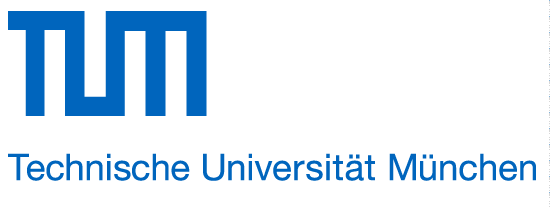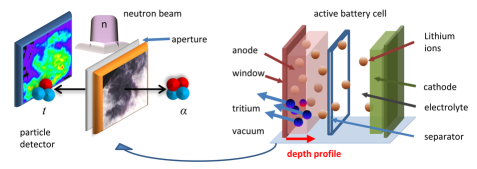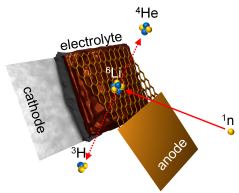MLZ is a cooperation between:
 > Technische Universität München
> Technische Universität München > Helmholtz-Zentrum Hereon
> Helmholtz-Zentrum Hereon
 > Forschungszentrum Jülich
> Forschungszentrum Jülich
MLZ is a member of:
 > LENS
> LENS > ERF-AISBL
> ERF-AISBL
MLZ on social media:

MLZ (eng)
Lichtenbergstr.1
85748 Garching
NDP
Neutron Depth Profiling

This instrument is focussed on cold neutrons. Therefore, please carefully check the “Technical data WITHOUT cold source” section. Deviating parameters are in bold. The instrument team is happy to answer any further questions!
Neutron Depth Profiling (NDP) is a nuclear analytical method based on determining the energy loss of charged particles in matter. This loss depends on the thicknesses and the densities of the layers between the place of emission and the detector. The new set-up at the PGAA facility enables a non-destructive quantitative analysis based on the maximum energies of the spectral shapes, as well as a reconstruction of the depth profiles based on the energy losses.
The method is very sensitive to certain light elements/ nuclides (3He, 6Li, 10B or 14N) with detection limits down to the ppb range. The depth resolution can be as good as 5 nm, but it is highly matrix-dependent. One of the most important applications of NDP is battery research (lithium-ion-batteries). An NDP measurement is also possible in operando during the charge cycles of batteries.
In a nutshell- Non-destructive depth profiling
- Detection of the following stable nuclides: 3He, 6Li, 10B, 14N, 17O, 33S, 35Cl
- Detection of radionuclides: 7Be, 22Na, 37Ar, 40K, 59Ni, 210Po
- Depth profiling is possible in almost any material matrix
- Depths <50 µm accessible (material-dependent)
- Max. depth resolutions 5 nm possible (material-dependent)
- Manufacture quality control
- Surface analysis of boron in Borofloat glasses (neutron-guide material)
- Boron implantation profiling in silicon substrates
- 3He implantation profiling in silicon substrates
- Fundamental nuclear physics
- Materials science and engineering
- Boron profiling in Co-Re-based superalloys for next-generation gas turbines
- Determination of composition and homogeneity of lithium-containing single crystals
- Energy systems
- Lithium immobilisation profiling in electrodes for lithium-ion batteries
- In operando tracking of lithium reversibly incorporated in electrodes during dis-/ charging
- Lithium-/ sodium-based electrodes for future battery systems beyond lithium-ion batteries
- Lithium-based systems for organic light emitting devices (OLEDs)
- Healthcare
- Tracking of lithium accumulation in the human brain (depression research)
- For bigger samples with collimation:
- Beam size: max. 20 × 30 mm2
- Neutron beam flux: ~ 108 n cm-2 s-1
- For smaller samples with 1.1 m elliptical neutron guide:
- Beam size: max. 11 × 16 mm2
- Neutron beam flux: ~ 2 × 109 n cm-2 s-1
- Areal sample size max. 150 × 150 mm2, sample sizes larger than 10 × 10 mm2 favourable
- Preparation: The thickness of samples has to be reduced as much as possible to minimise the background signal
- For bigger samples with collimation:
- Beam size: 20 × 30 mm2
- Neutron beam flux: ~ 2 × 109 n cm-2 s-1
- For smaller samples with 1.1 m elliptical neutron guide:
- Beam size: 11 × 16 mm2
- Neutron beam flux: ~ 4 × 1010 n cm-2 s-1
- Areal sample size max. 150 × 150 mm2, sample sizes larger than 10 × 10 mm2 favourable
- Preparation: The thickness of samples has to be reduced as much as possible to minimise the background signal
Instrument scientists
Dr. Zsolt Revay
Phone: +49 (0)89 289-12694
E-mail: zsolt.revay@frm2.tum.de
Dr. Christian Stieghorst
Phone: +49 (0)89 289-54871
E-mail: christian.stieghorst@frm2.tum.de
Operated and funded by

Publications
M. Trunk, M. Wetjen, L. Werner, R. Gernhäuser, B. Märkisch, Zs. Revay, H. Gasteiger, R. Gilles, Materials Science Applications of Neutron Depth Profiling at the PGAA facility of Heinz Maier-Leibnitz Zentrum. (2018). Materials Characterization, 146, 127-134, https://dx.doi.org/10.1016/j.matchar.2018.09.030
M. Wetjen, M. Trunk, L. Werner, R. Gernhäuser, B. Märkisch, Zs. Revay, R. Gilles, H. Gasteiger, Quantifying the Distribution of Electrolyte Decomposition Products in Silicon-Graphite Electrodes by Neutron Depth Profiling. (2018). Journal of The Electrochemical Society, 165, 10, A2340-A2348 , https://dx.doi.org/10.1149/2.1341810jes
M. Wetjen, M. Trunk, L. Werner, R. Gernhäuser, B. Märkisch, Zs. Revay, R. Gilles, H. Gasteiger, Monitoring the Lithium Concentration across the Thickness of Silicon-Graphite Electrodes during the first (De-)Lithiation. (2019). Journal of The Electrochemical Society, 166, 8, A1408-A1411. https://dx.doi.org/10.1149/2.0581908jes
Citation templates for users
In all publications based on experiments on this instrument, you must provide some acknowledgements. To make your work easier, we have prepared all the necessary templates for you on this page.
Related News
MLZ is a cooperation between:
 > Technische Universität München
> Technische Universität München > Helmholtz-Zentrum Hereon
> Helmholtz-Zentrum Hereon
 > Forschungszentrum Jülich
> Forschungszentrum Jülich
MLZ is a member of:
 > LENS
> LENS > ERF-AISBL
> ERF-AISBL
MLZ on social media:




